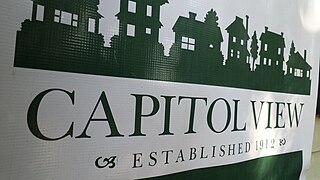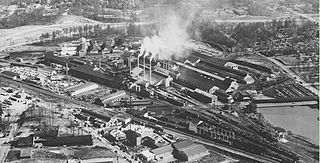
Westside Provisions is a mixed use neighborhood located in the West Midtown area of Atlanta, Georgia, United States. [1]

Westside Provisions is a mixed use neighborhood located in the West Midtown area of Atlanta, Georgia, United States. [1]

Westside Provisions was formed in 2008 by the construction of a footbridge linking the Westside Urban Market to White Provision. White Provision occupies the White Provision Co. building, constructed in 1910 and expanded in 1922–1924 in the Industrial Gothic style. It served as a meat packing plant and was sold to Swift and Company. In 1963 the property was converted into a bonded warehouse and in 1991 as a U-Haul storage center and as residential lofts. Westside Urban Market is built on the site of the 1917 United Butchers Abattoir, later the site of Stovall and Co. [2] Both the abattoir and meat packing facility were established in proximity to the Miller Union Stockyards then located in the area from the 1880s through 1940s. [3]
Westside Provisions includes dining and national retailers. [4] For retail, the development is anchored by a large Room & Board furniture store as well as Atlanta's second Anthropologie. [5] [6] [7] The district includes additional restaurants, coffee shops, and high end home furnishings and apparel stores.

In livestock agriculture and the meat industry, a slaughterhouse, also called an abattoir, is a facility where livestock animals are slaughtered to provide food. Slaughterhouses supply meat, which then becomes the responsibility of a meat-packing facility.
East Atlanta is a neighborhood on the east side of Atlanta, Georgia, United States. The name East Atlanta Village primarily refers to the neighborhood's commercial district.
The Atlanta BeltLine is a 22 miles (35 km) open and planned loop of multi-use trail and light rail transit system on a former railway corridor around the core of Atlanta, Georgia. The Atlanta BeltLine is designed to reconnect neighborhoods and communities historically divided and marginalized by infrastructure, improve transportation, add green space, promote redevelopment, create and preserve affordable housing, and showcase arts and culture. The project is in varying stages of development, with several mainline and spur trails complete and others in an unpaved, but hikeable, state. Since the passage of the More MARTA sales tax in 2016, construction of the light rail streetcar system is overseen by MARTA in close partnership with Atlanta BeltLine, Inc.

The Union Stock Yard & Transit Co., or The Yards, was the meatpacking district in Chicago for more than a century, starting in 1865. The district was operated by a group of railroad companies that acquired marshland and turned it into a centralized processing area. By the 1890s, the railroad capital behind the Union Stockyards was Vanderbilt money. The Union Stockyards operated in the New City community area for 106 years, helping Chicago become known as the "hog butcher for the world," the center of the American meatpacking industry for decades. The yards became inspiration for literature and social reform.
Arbogast & Bastian, also known as A&B Meats, was the name of a slaughterhouse and meat packing plant located in Allentown, Pennsylvania. Once a national leader in hog slaughtering, the company had the capacity to process most of the 850,000 hogs raised annually in Pennsylvania for slaughtering. In its heyday, Arbogast & Bastian slaughtered an average of 4,000 hogs daily.

Grove Park is a northwest Atlanta, inside-the-perimeter neighborhood bounded by:

Located at 695 North Avenue in Atlanta, the Dupre Excelsior Mill may have been built as early as 1890 by DuPre Manufacturing Company. However, the mill fails to appear on Atlanta city maps in 1892 and 1899, which both show the property as vacant. The first possible reference to the mill exists in the report of the death of Hubert Neal on July 17, 1899. According to the report, his accident occurred at the Atlanta Excelsior Works, which may or may not be the same facility since at the time there were three excelsior factories in Atlanta. The earliest concrete confirmation of the mill seems to be three lawsuits filed against Dupre in 1907 for accidents that occurred at the facility. The mill does appear on the Sanborn-Perris fire insurance map of 1911. At that time, the only road connecting it was Angier Street. It was noted to have been heated by steam power, no lighting, and a private water supply from a well 10 feet in diameter and 40 feet deep. A watchman made hourly rounds to seven stations.

Westview is a historic intown neighborhood located in southwest Atlanta, Georgia. It is named for the Westview Cemetery that borders the neighborhood to the northwest. The neighborhood is made up of a mixture of architectural styles including Arts & Crafts bungalows, Four-Squares, Tudors, Minimal Traditional houses, and Ranch style houses.

Capitol View is a historic intown southwest Atlanta, Georgia neighborhood. The neighborhood is 2.5 miles from downtown and was named for its views of the Georgia State Capitol building. Its boundaries include Metropolitan Parkway to the east, Lee Street to the west, and the Beltline to the north. On the south, the border follows Arden Street, Deckner Avenue, and Perkerson Park.
Upper Westside is a colloquial area, comprising many historical neighborhoods located in Atlanta, Georgia. The neighborhood is located in the northwestern sector of Atlanta, west of I-75 and inside I-285, to the south of Vinings and to the west of Buckhead. It was developed in the 19th century as an industrial hub.
Atlanta, the largest urban center in the southeastern U.S., has undergone profound social, cultural and demographic change since the 1980s. Prior to that time, the region contained two main ethnic groups: European Americans and African Americans. However, from 1980 to 1995, the Hispanic population of Georgia grew 130%. By 1996 there were 462,973 Hispanics in Georgia. From 1990 to 2000, Georgia became the third largest state for migrating Hispanics and Latinos.
West Midtown, also known as Westside, is a colloquial area, comprising many historical neighborhoods located in Atlanta, Georgia. Once largely industrial, West Midtown is now the location of urban lofts, art galleries, live music venues, retail and restaurants.

Ponce City Market is a mixed-use development located in a former Sears catalogue facility in Atlanta, with national and local retail anchors, restaurants, a food hall, boutiques and offices, and residential units. It is located adjacent to the intersection of the BeltLine with Ponce de Leon Avenue in the Old Fourth Ward near Virginia Highland, Poncey-Highland and Midtown neighborhoods. The 2.1-million-square-foot (200,000 m2) building, one of the largest by volume in the Southeast United States, was used by Sears, Roebuck and Co. from 1926 to 1987 and later by the City of Atlanta as "City Hall East". The building's lot covers 16 acres (65,000 m2). Ponce City Market officially opened on August 25, 2014. It was listed on the National Register of Historic Places in 2016.
Marietta Street Artery is an officially defined neighborhood of the city of Atlanta, Georgia, part of the West Midtown area of Atlanta, also known as the "Westside."

The Atlantic Steel Company was a steel company in Atlanta, Georgia with a large steel mill on the site of today's Atlantic Station multi-use complex.

Rhodes Center was Atlanta's first shopping center. It was built in 1937 by architects Ivey and Crook and was one of the largest real estate developments in Atlanta during the Depression.
Blandtown is a neighborhood of the West Midtown area of Atlanta, Georgia. It is located along either side of Huff Road from Howell Mill Road west to Marietta Blvd. It was one of the first black settlements around Atlanta after the Civil War, named for a Black man who owned property. As a community it declined from the 1950s through 1990s, following racially motivated rezoning and a general flight from cities to suburbs. It now forms part of the West Midtown area, a rapidly developing part of Atlanta known for its home furnishings stores, new apartment and condo complexes, restaurants and bars.
The King Plow/Railroad Historic District is a proposed historic district in Midtown West, Atlanta, Georgia. Creation of the district was approved at the state level in 2001 but it has not yet received national certification.

Krog Street Market is a 9-acre (3.6 ha) mixed-use development in Atlanta, located along the BeltLine trail at Edgewood Avenue in Inman Park which opened in Summer 2014. The complex is centered on a 12,000-square-foot (1,100 m2), west coast-style market and restaurants, and also includes up to 300 apartments. The marketplace has been planned to have four or five restaurants and merchants such as florists, cheesemakers, butchers, and bakers under one roof. It is to incorporate two existing parcels on either side of Krog Street: The Stove Works on the west side and the former Tyler Perry Studios at 99 Krog Street, on the east side. The conversion to Krog Street Market is to cost $70 million. The Stove Works is to remain unaltered. Illustrations in the plans show the existing bridge over Krog Street renovated as a pedestrian bridge and incorporated as part of the complex.

Midtown West is a 12-acre commercial development in West Midtown, Atlanta. It consists of historic warehouse space renovated for use as restaurants, other hospitality and offices. It includes the Brickworks building at the intersection of Howell Mill Rd. and Marietta St.